In 1989, New York City’s larger-than-life center became his own brand. Learn why Ewing Athletics continues to earn decades later, in The Big Apple and beyond.
David Stern or David Blaine?
On May 13, 1985, fans across America tuned into basketball’s biggest spectacle of the year. No, it was not Michael Jordan defying gravity in his debut Dunk Contest, nor was it was a grudge match between Magic Johnson and Larry Bird in the NBA Finals.
Rather, it was the first-ever NBA Draft Lottery.
Broadcast live on CBS, the master of ceremonies was a 5’9 showman in a suit, performing a sleight of hand illusion Harry Houdini couldn’t muster.
For his first trick, Stern, the young successor to Larry O’Brien as NBA Commissioner, brought out a giant glass drum, loaded with seven oversized envelopes tied to cellar-dwelling teams. As the lottery hopper spun in circles, both Stern and the audience held their breaths.
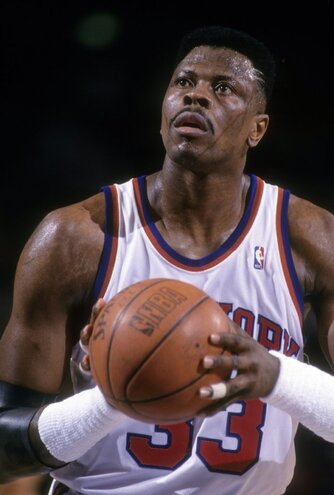
Letting out an audible sigh, Stern reached into the hopper, magically turning one elusive envelope into one city’s savior.
The New York Knicks, a franchise backed by 1.5 million hoop hungry fans, just won the rights to select Patrick Ewing: Georgetown’s 7-foot force who bullied the Big East for four years straight.
Through Stern — not just a magician, but a made-in-Manhattan marketing maestro raised at Madison Garden — the league now had a bankable star in its largest market.
More importantly for Ewing, he now had that massive market at his feet.
“Patrick was the highest-paid player in the history of the league when he was a rookie,” legendary agent David Falk told Boardroom.
A cash cow upon his arrival and an icon to this day, Patrick is ’90s New York personified. As a businessman, there’s a deeper story.
Back in 1989, just years after Stern pulled the magic envelope, Patrick accomplished the unthinkable. With his agent, he launched Ewing Athletics: a footwear company built on the broad shoulders of the Big Apple’s big man.
Boardroom breaks down the business of how the company came to be, and also how it came back.
Checks Over Stripes?
Entering the 1985 NBA Draft, Patrick Ewing was already a coveted commodity among sportswear superpowers.
For four years in DC, Pat’s size 15 Nikes brought cool cache to teenagers that adored John Thompson’s bold brand of basketball.
Because Thompson was on the Board of Directors in Beaverton, it was all but assumed that the Swoosh would sign Ewing to face their Force line.

“Patrick was a Nike athlete all through Georgetown,” former Nike Basketball Head of Category Brad Johnson told Boardroom in Sep. 2022.
“Rob Strasser called a meeting and Peter Moore introduced the E-Force line. That was going to be the counter to Air Jordan and it was going to be Patrick Ewing’s collection.”
As the tale of the tape tells it, Falk — the brains behind Michael Jordan’s legendary deal with Nike — entertained all options for Ewing, as any agent would.
Across the pond, international powerhouse Adidas had offered $750,000 to endorse Ewing. For Falk, this was major money as he’d just gotten Jordan an unprecedented $500,000 from Nike only one year prior.
Smartly, Falk applied pressure on Nike to match the lofty offer from Adidas — an internal decision that forced Swoosh execs to decide by way of an 11th hour public vote.
“The last guy is Peter [Moore], who’s at the head of the room sitting next to Rob,” Johnson recalled. “He just designed the entire collection and concept for Patrick Ewing, so everyone is thinking he’s gonna say we’ve gotta sign him.”
The tension rises…
“He looks at the room and goes, ‘I don’t know if we should sign Patrick Ewing or not. I do know one thing: I know that I don’t want to be the guy that’s gonna call up Michael Jordan and tell him, ‘We just signed Patrick Ewing for $250,000 a year more than what we paid you — and we have you under contract for four more years at that price.’”
And just like that, basketball’s biggest attraction becomes Adidas America’s leading man.
A match made in marketing heaven, The Three Stripes suddenly had New York City on lock. Nike’s loss was absolutely Adi’s gain and the timing couldn’t be better.
Upon arrival, Pat put up 20 points a night and took home Rookie of the Year honors. The same spring, Run-DMC released “My Adidas,” aligning Manhattan’s hardwood savior in spirit and sole with the kings of rock, cardboard, and concrete from Queens.
In both Ewing and the hip hop trio, Adidas had roughly $1.75 million invested in New York influencer marketing. At that moment, they also had top-tier product to match.
For Ewing’s early ascent with the Knicks, Adidas outfitted him in marquee models like the Forum, Conductor, Rivalry, and Attitude.
Everything was going exactly to script until disaster struck.
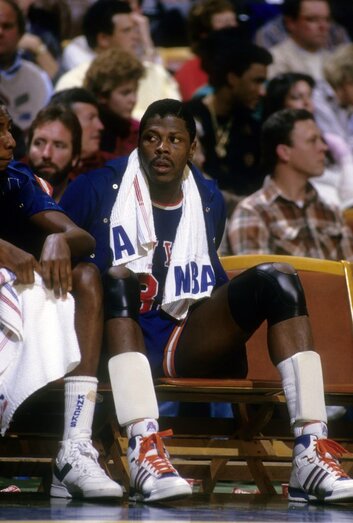
On April 9, 1987, Adidas chairman Horst Dassler died. Coming just a few years after his father and Adidas found Adi Dassler passed, the brand was in limbo, and all aboard knew it.
Those close to the top at Adidas approached Falk, allowing Ewing to walk from his contract as the German juggernaut focused on family matters back home.
Citing the lack of leadership, exiting the agreement made sense for all parties.
“We negotiated a release,” Falk said.
Not even two whole seasons into his Adidas deal, Ewing and Falk were facing footwear free agency all over again.
So, would they take less money at Nike and form E-Force? Or would they do something drastically different that the world had never seen?
Blankman
Months after Dassler’s death, Ewing took centerstage in the 1988 NBA All-Star Game.
Set in Chicago, Falk’s fellow client, Michael Jordan, stole the showcase in flair and footwear.
Debuting the Air Jordan 3, Mike’s Jumpman-branded shoes saw art imitate life as the stylish scorer soared from the free throw line in that afternoon’s Dunk Contest. As an encore that evening, Mike took home his second trophy of the day, ASG MVP.
In that same exhibition, Ewing wore high top Adidas sneakers for the first and last time in an All-Star outing.
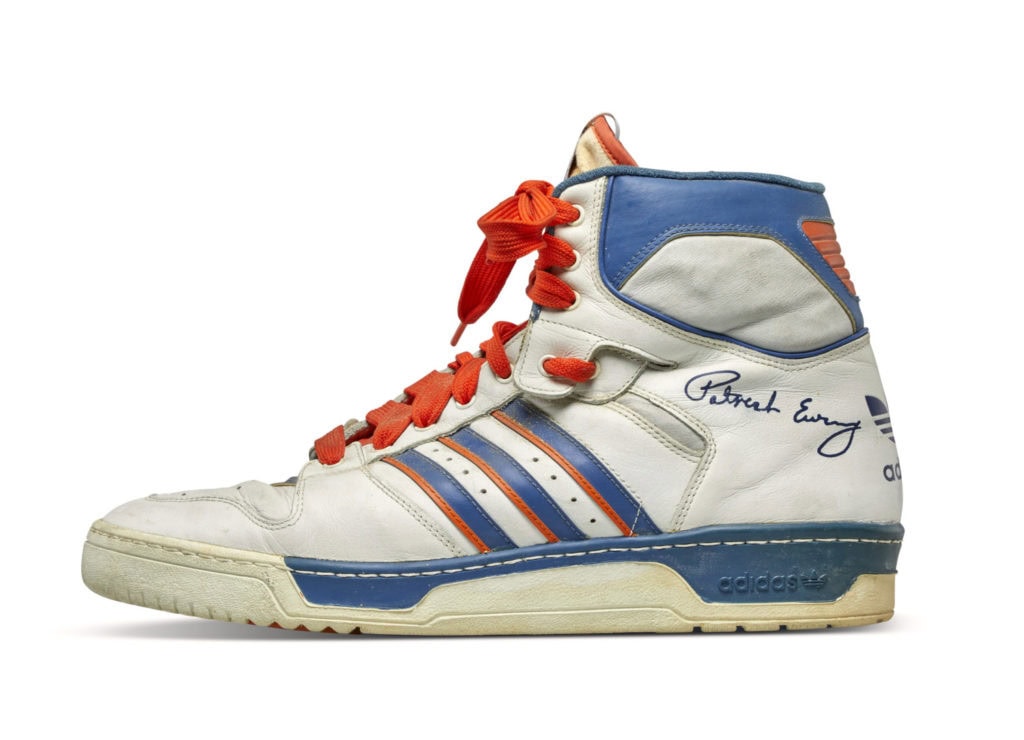
The puffy, padded leather look was signature to the times and akin to the company based on the Three Stripe sidewall branding.
A year later in the Astrodome, Ewing would wear the same shoe in shape, but dramatically different when it came to corporate marking.
Shortly after negotiating a release from Adidas, Falk reached out to longtime friend Roberto Muller. Born in Uruguay before migrating to Manhattan, Muller made it in America by founding PONY: an independent footwear company standing for Product of New York.
Since starting in 1972 — the same year as Nike — Muller had built up a rolodex of not just agents and athletes, but also manufactures from far and wide when it came to producing product.
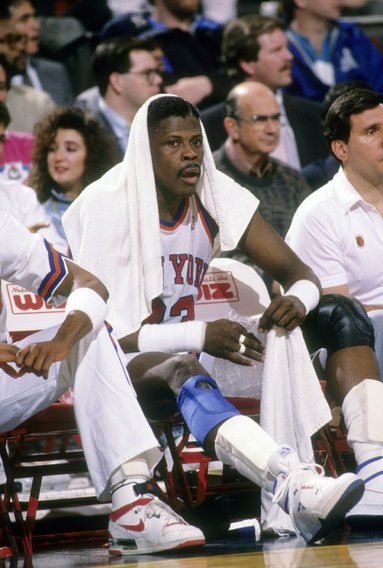
Seizing the moment, Falk pitched Muller with an idea unlike anything he’d heard before.
“I asked him if he could make a shoe similar to what Patrick had worn with no logos whatsoever in pure white,” Falk said. “Before we sign another shoe contract, I want to create a buzz about what Patrick is wearing. I want to be mysterious.”
Over the course of the 1987-88 NBA season, Ewing played in basketball’s biggest market in completely unbranded sneakers.
These in-game prototype pairs were almost identical to his Adidas looks in previous seasons, now devoid of the striping and team tones that literally gave the Attitude, well, attitude.
Untied to Run-DMC momentum or residual checks, it was perhaps the most punk rock experiment ever seen in NBA footwear.
More impressively, it was all ideated by the world’s most powerful agent who’d literally made a living off aligning his clients with massive corporate endorsements.
“It created quite a buzz,” Falk said. “People were curious. After a period of time Roberto said, ‘If Patrick were open to it, we’d love for Patrick to create his own company.’ Having just done Air Jordan? I loved the idea. I loved the idea of Patrick having his own brand instead of just being an endorser.”
Once again, the massive market of New York was at Ewing’s feet.
No longer would he need a brand backing him, he’d soon be the brand.
One Man Brand Man
Heading into the 1990 NBA All-Star Game, Patrick Ewing was approaching his peak.
Averaging almost 29 points a night at only 27 years old, the King of New York was now the starting center for the Eastern Conference squad.
Amassing more votes than anyone not named Michael or Larry, the fifth-year veteran took to the court with said superstars by his side. Rounding out the starting lineup were the likes of Isiah Thomas and Charles Barkley.
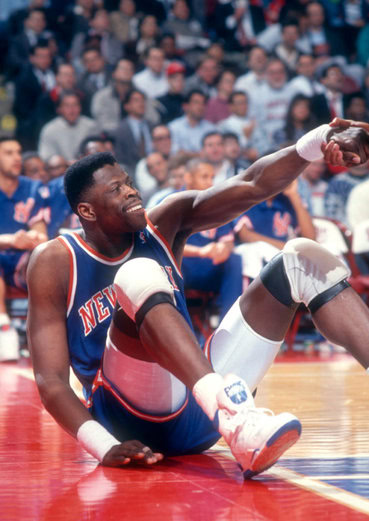
At this juncture of David Stern’s master plan, the NBA was becoming global with all starters for the East having their own shoe deals.
However, it was the man tied to the magic envelope that now had his own brand.
That night, the East trounced the West as Ewing recorded a double-double while manning the middle.
On his feet were the Ewing Athletics 33 Hi, the top-tier court model from him and Falk’s new footwear company.
Miles away from the exhibition in Miami, fans from New York noticed their hoop hero’s new shoes.
“I grew up in New York as a huge Knicks fan,” David Goldberg told Boardroom. “I was 10 years old when the 33 Hi came out. You saw hip hop artists and kids at school wearing it. It was something really different at that time.”
Coming up in the city, Goldberg grew up on the ’90s nostalgia associated with hoops, hip hop, and the Mecca he called home. All the cultures collided through kicks, and it was Ewing Athletics that represented an overlap for all things New York.
Building the brand in conjunction with Albany-based Phoenix Footwear Group, Inc., Falk and Ewing had been prototyping shoes on court and in the market for roughly a year before hitting it big with the 33 Hi.
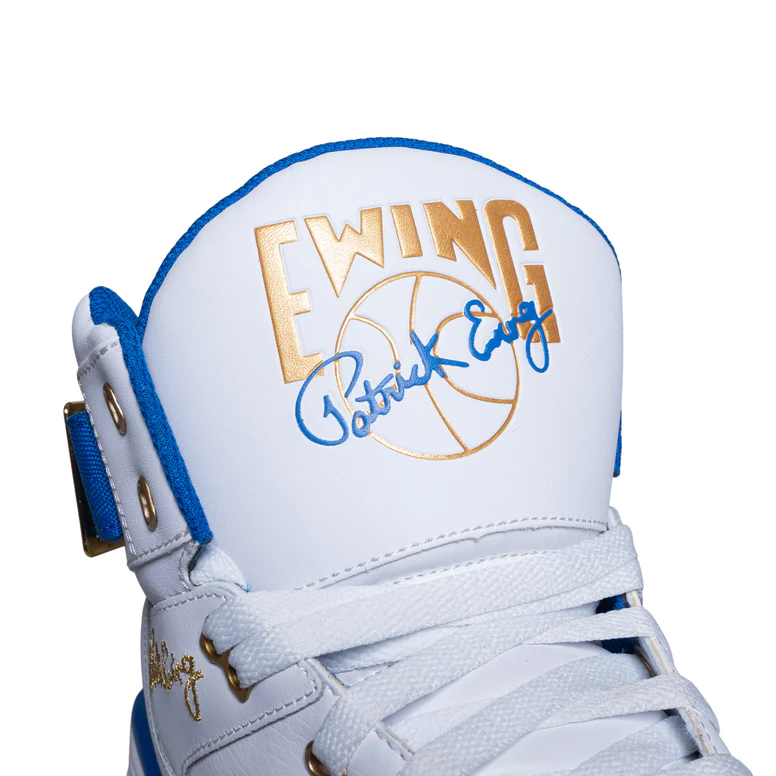
“They started with the Rebound, a lower-end affordable shoe that was like $40,” Goldberg said. “It wasn’t that good, but he wore it in the 1988-89 season. The next year, they came out with the 33 Hi which was $75 at retail.”
In the 33 Hi, Ewing Athletics had a model that could undercut Nike, Adidas, and Reebok in price point but still deliver a level of quality and value. With Patrick’s play, the massive local market, and the brand’s evolution, the positioning proved perfect.
“That shoe took off rapidly in New York,” Goldberg said. “Phoenix didn’t have great distribution, so it was really only on the I-95 corridor in urban, East Coast stores.”
In a matter of months and in seasons to follow, Ewing Athletics grew and grew.
Soon, Foot Locker stores across the country were distributing Patrick pairs. After taking home gold in the 1992 Summer Olympics, Ewing Athletics had demand and exposure that tracked overseas.
“The Dream Team exposed the brand worldwide,” Goldberg said. “The Dream Team was so big that everyone got exposed to international basketball. And only two players on that team had their own signature shoe: Ewing and Jordan.”
In MJ and Ewing, Falk forecasted basketball’s biggest breadwinners of the early ’90s where sneaker sales were concerned.
Though Jordan was the alpha dog in respect to sales and royalties, Patrick proved profitable due to the unique structure of being the first hoop superstar with his own bankable brand.
“The majority of players who have endorsement relationships simply get paid to wear shoes,” Falk said. “The elite players, since Michael, have their own signature. In this case, it was the ultimate step where Patrick actually owned a significant piece of the company.”
How significant?
“It was more than simply royalty income,” Falk said. “He actually owned 20 to 25% of the entire company.”
Because of this, Patrick was possessed not just to handle business on-court and appear in commercials. Rather, he was incentivized to put in his all when it came to every exposure for the brand that was very much his.
“He was building his own brand that he owned equity in,” Falk said. “It really was a dramatic step in the evolution of athletes as brands.”
By ’94, the Knicks were in the Finals and Ewing Athletics was being stocked by Eastbay.
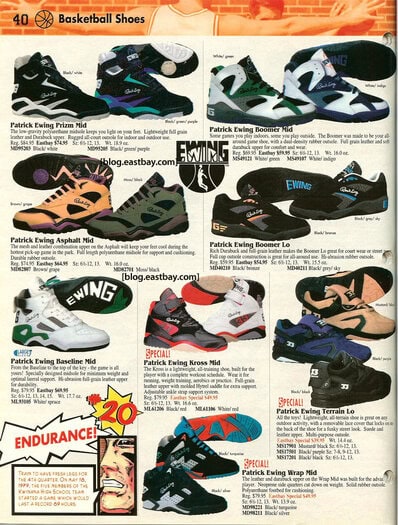
It was much more than the 33 Hi: the mammoth mail-order catalog was stocking multiple models ranging from $40 to $80.
No longer built strictly for hardwood, Falk and Patrick had produced a wide range of sneakers built for asphalt runs and stunting in the city.
This boom proved both a blessing and a curse.
“Everybody was kind of unprepared for how big it got so quickly,” Goldberg said.
“When you think about it, Jordan had one shoe a year in four colorways. By ’92, Pat has 10 or 15 models a year in six or seven colors. It went from him having the 33 Hi to a whole company so quickly.”
Quickly, the operation was too big for all involved.
Heavy was the crown for the King of New York. Leading a championship-caliber team in the rough-and-tough ’90s was back-breaking enough. Running a multi-million-dollar footwear enterprise was just as taxing in his off-hours.
“Patrick had a dispute with the shippers that were discounting it more than they should have,” Goldberg said. “He had the brand shutdown in 1995.”
Once again, Falk and Ewing had made millions and defied the odds.
Once again, they were footwear free agents tasked with figuring out what was next.
Lights Out for Ewing Athletics
Over the course of the next five seasons, a lot happened for David Falk, Patrick Ewing, and the footwear industry at large.
Shortly after shutting down Ewing Athletics in ’95, Michael Jordan was not just back in the basketball world — he was back on top of it.
Thought to be retired in ’93, Nike was on track to shut down the Air Jordan franchise as we know it. As we all know now, MJ came back after a brief baseball sabbatical, going on to win three more rings.
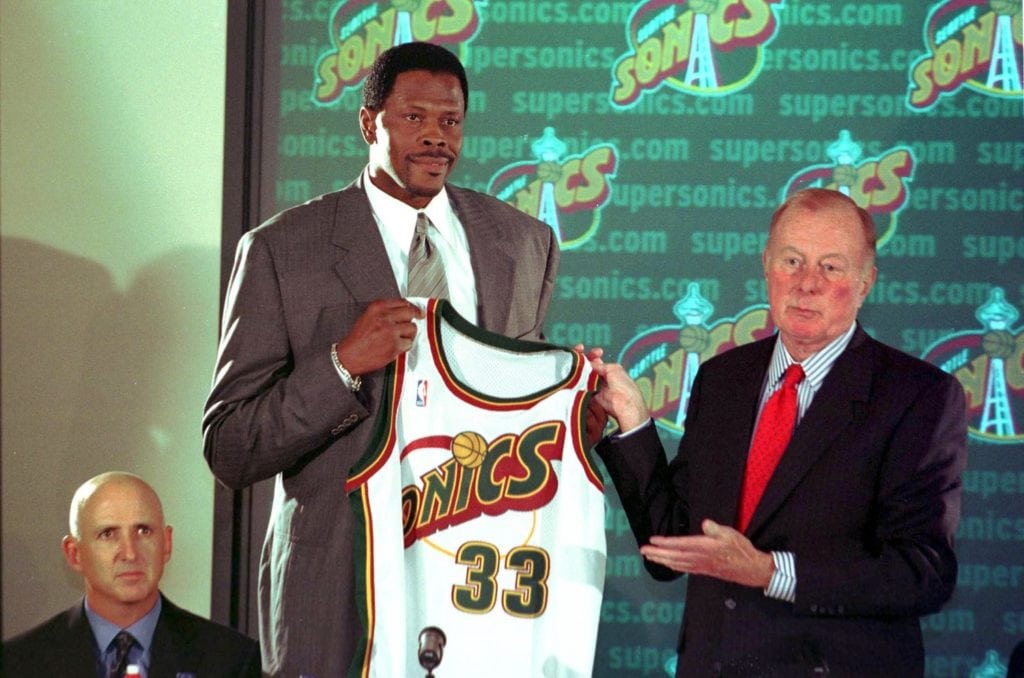
In Sep. ’97, Nike gave Mike his own subsidiary in the form of Jordan Brand. The fellow Falk client had climbed the same corporate ladder as Ewing, simply scaling it from another angle.
While Mike was winning on the hardwood and in the boardroom, Patrick was still playing at an All-Star level, but soon struggling to stay healthy.
By the turn of the century, the same city that adored Ewing in the ’80s and early ’90s now looked to new athletes for inspiration. This led to an unceremonious exit from New York, with the storied center ending his career with sole seasons in Seattle and Orlando.
As the ’00s took shape, Ewing took on new roles in both basketball and business. All the while, Falk remained active for all his clients.
Throughout the ’00s, Jordan Brand blossomed into a global giant. Today, the Jumpman logo makes more than $5 billion a year.
Though Patrick paved the way for Mike to have his own company, Mike returned the favor by creating an appetite for retro basketball sneakers. It was a shift in the industry few could’ve predicted, and one that still surges. Around the world, the likes of Nike, Adidas, Reebok, and more made bank by bringing back basketball shoes from the ’80s and ’90s.
In the late ’00s, most fans forgot about Ewing Athletics. However, childhood fan David Goldberg did not. As an adult working in the hotel industry, Goldberg used his off hours and disposable income to scour eBay for the forgotten sneakers that Ewing once sold.
By 2009, he had nearly 30 pairs of OG Ewing Athletics shoes. He also had the guts to reach out to the most powerful agent in sportswear history.
“I had met some people who had a connection to approach Falk about bringing it back,” Goldberg said. “I was definitely intimated to deal with him at first, but he’s a super nice guy.”
Pouring out his soul to Falk, Goldberg shared his dedication for Patrick and the Ewing Athletics brand.
He was honest to admit that he had absolutely no experience in the sportswear industry, but believed in the passion project so much that he’d invest his own money into making it happen.
Falk, a man who’s had to stare down Phil Knight, Jerry Reinsdorf, and David Stern on multiple occasions, was impressed by the spirt of the industry unknown who’d got his attention.
“Several different groups had approached us about bringing the shoe back,” Falk said. “When you work with someone of Patrick’s stature, you err to the side of protecting his reputation.”
This meant making sure Pat looked good as an athlete, a businessman, and icon in New York.
“We weren’t comfortable with some of the people who first approached us, but when we met with Dave? I really liked Dave,” Falk said. “I trusted him that they were going to take it slow and not blow it out. We really liked the game plan so we agreed to try it.”
Impressed by Goldberg’s reverence for the Ewing name and his business plan, Falk took a chance on the fan the same way his athlete took a chance at footwear free agency 20 years prior.
All intentions were good, but could it actually work?
Ewing Athletics: Back in Business
For almost three years, David Goldberg worked behind the scenes to revive Ewing Athletics from the ground up.
Having an array of archival shoes but zero years of industry experience, he dug deep and figured it out on the fly.
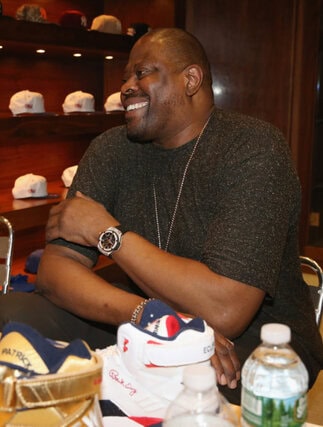
“It was a long process from meeting them to actually producing shoes,” he said. “Getting a warehouse and all these things I really had no clue about.”
Citing good people with him and a booming basketball market, Ewing Athletics relaunched in 2012 with next to no expectations of how this whole experiment would actually go.
One could say it was an even wilder risk than Falk’s foray with Patrick in the ’80s — namely because the big man hadn’t hit a jump hook in over a decade.
Still, the love for Patrick had only grown stronger since his playing days in the Big Apple.
Just the same, the city’s population had swollen to 8.6 million by the time of return.
“Patrick’s situation is very unique,” Falk said. “Because his popularity in New York was so strong that Ewing Athletics is still selling at a significant level despite the fact that Patrick hasn’t played basketball in 20 years.”
Upon its return under Goldberg, active president at Ewing Athletics, the brand took off in its retro life in NYC and beyond. Through Falk’s contacts, Goldberg was able to strategically place pairs in doors along the brand’s backyard of the I-95 corridor.
Without spending on seeding, New York natives like A$AP Rocky and Teyana Taylor organically bought pairs, performing in 33 Hi retros on stage and posting them on their social media accounts.
The press was free. The returns were substantial.
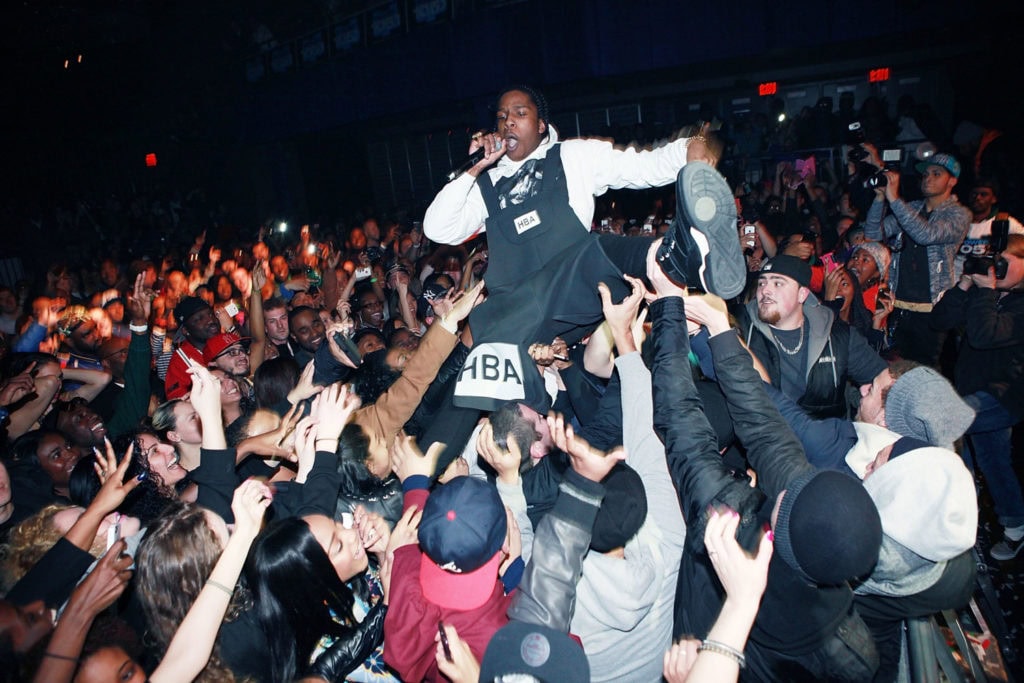
“When we relaunched the brand, he was making seven figures a year for a good period of time,” Falk said. “Which is amazing for someone who hadn’t played in a long time.”
Since returning, Goldberg has continued to grow the brand organically while eliciting insight from those that share his passion.
In recent years, Ewing Athletics has leaned into hip hop heritage by collaborating with the likes of Big L, EPMD, AZ, and other golden era NYC acts as a means to restore the feeling and keep the brand moving.
Unlike the bootstrap restart where seeding shoes was an afterthought, Ewing Athletics is empowering estates and living legends to tell stories.
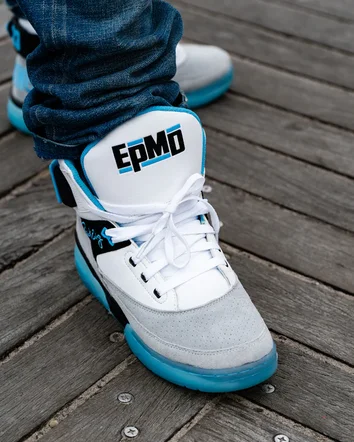
This all adds up to winning business for all involved, showcasing not just the selling power of New York nostalgia, but the brand’s ability to take care of its own.
“Everything is really collaborative and hands on,” Jonas Guerrero, Product Line Manager at Ewing Athletics, told Boardroom.
“There’s no one here taking advantage of the artists. We pay them and allow them to tell their story. When we reach out to artists, they’re happy because other brands aren’t reaching out to do shoes with them or cut them into deals.”
It’s with that level of authenticity and respect that Ewing Athletics has not just been able to thrive in its second life, but continue its comeback run just the same.
This is not lost on anyone in the company, especially the fan that took a chance and met with Falk.
“A lot of people had reached out to him over the years to bring the brand back,” Goldberg said. “They didn’t want to do the deal that was just the biggest paycheck up front, they appreciated the sincerity I had towards the brand and that I was going to do it long term.”
To this day, the sincerity means more than the paychecks, even if earnings remain consistent.
“They didn’t care if it was going to be a billion dollar company, they just wanted it to reflect well on Patrick’s name and the brand,” Goldberg said.
While Patrick Ewing might not always get the props or flowers for being the first basketball beacon with his own shoe brand, his footprints are all over the industry.
Paving the way for Michael Jordan and Stephen Curry while doing so in New York, Ewing is a trailblazer in the footwear space even if his accolades as a player and coach proceed it.
In 2022, a decade after its relaunch and almost 35 years since the super agent and superstar took the leap, Ewing Athletics is still here and still standing.
“People thought it was a niche brand that would only be here for a year or two,” Guerrero said. “Here we are 10 years later and I feel like we’re stronger than ever. We’re totally independent and it’s a labor of love.”
For everyone at Ewing Athletics — from Falk to Patrick himself — it’s as if they won the lottery, magical as it may seem.
Read More:
- Damian Lillard, Bradley Beal, & the NBA’s Record Buyouts: What’s Really Going On?
- Drake’s New Single Starts a Cold, Calculated Return to the Top
- Paris Saint-Germain is on the Brink of the Greatest Soccer Season Ever
- Inside MLB’s Master Plan to Host All-Star Week in Atlanta
- Coming Soon: The 16 Movies Set to Dominate the Rest of 2025